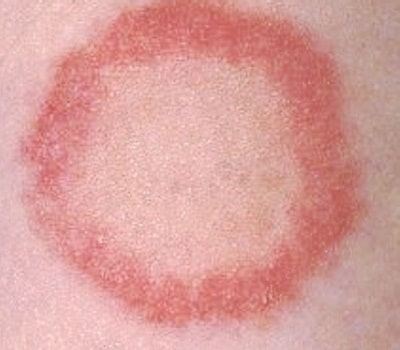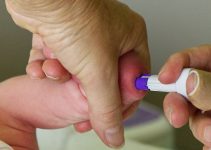Ringworm is not a name of a disease caused by worms or parasites. It is a common fungal skin/topical infection found in people of all age groups. It is not a life-threatening condition.
Nonetheless, it causes lots of discomfort to babies. It may also indicate poor hygiene, health, or immunity.
It is called ringworm, as it causes a typical round rash. Such a rash may occur on just any part of the body, but more commonly it happens on the face, scalp, neck.

Figure 1: typical round rash caused by ringworm
Source: nhs.uk (modified)
Although such an infection may be caused by more than 40 type of fungi, but in most cases, it is due to Trichophyton, Microsporum, or Epidermophyton.
How common is ringworm in babies? And it’s causes
It’s prevalence or risk of contracting, symptoms, type of fungi involved, will depend on many factors. Thus, ringworm is more common in warm and humid conditions. It is more frequently found among people of lower socio-economic status.
Similarly, pre-term babies or immunocompromised babies are at higher risk. Risk also increases when children start going to school [1].
Generally, babies and children get infected by coming in contact with contaminated soil, infected objects like combs or bedsheets, or may contract through infected animal or a person.
The severity of infection will depend on the immune status and genetics. Some children are more prone to fungal infections, while others may merely act as carriers and may not develop any symptoms.
Ringworm was almost eradicated among babies, children, and adolescents in the mid-20th century when first effective drugs were introduced. However, for last few decades, fungal infections are making a comeback along with the emergence of resistance to the commonly used medications.
Nowadays, these infections are found in 2-3% of babies or children, and a large number of school-going children are carriers of these infections [2]. Carrier means that a person may not have any visible sign of the disease, but they may still spread infection.
Pattern and the location of rash, and its causes (type of fungi involved) change according to the age of children. Among the babies and young children, ringworm of scalp is more common. It is frequently caused by Microsporum canis.
As children grow, ringworm of other body parts become more common. If the infection is on the neck, chest, back, or other body parts than is it more probably due to Trichophyton rubrum. Studies also suggest that the risk of dermal fungal infections is highest in the autumn [3, 4].
Signs and symptoms of ringworm
Quite often identifying ringworm infection does not pose any difficulty due to characteristic ring-shaped rash. However, it is necessary to understand that it may not always cause such a kind of rash.
In many cases there may be multiple patches, often merged with each other, red in color, with scaly skin. In some cases, the rash may look like eczema. Ringworm infection is very itchy, but again babies may not be able to tell that, instead they may cry more often.
Among babies and children, scalp infection is more common. Initially, it may be confused with dandruff or eczema. In later stages, it may attain its typical round form. Further, there will be a hair loss at the point of infection.
It means that ringworm of scalp is characterized by patchy baldness, something that cannot be confused with any other disease.
One way to differentiate ringworm from eczema is to note that the center or ring will have a more or less clear area. Other body areas commonly infected among babies are cheeks, chins, forehead, nose.
Some children may also develop ringworm of the body. However, infection of groins and feet is more common among teenagers and adults.
Usually, ringworm is diagnosed solely through the visual inspection or physical examination, and no other test is required. However, in some cases, the doctor may scrape a part of the skin and examine it under a microscope. The doctor may also order some blood tests to ensure the wellbeing of the baby.
Preventing ringworm infection in babies
Ringworm is highly contagious. You can prevent a baby from contracting it by keeping things clean, washing hands when touching a baby. Ask other siblings to wash hand before touching a baby.
Pay particular attention to the hygiene of school going children. Keep clothing dry, especially if you live in a warm and humid area. Do not share hairbrushes, towels, clothing, and other items. Make sure that your pets are also free from fungal infections.
If your baby or a child is prone to fungal infections, you may consider using special medicated soaps. Antifungal shampoo is quite useful in preventing scalp infections. You can also buy an antifungal solution for your baby.
It is worth knowing that most of the essential oils have antifungal properties. So, you can massage your child with such oils. Eucalyptus, lavender, chamomile, tea tree oil, all can help prevent fungal infections. However, always make sure that your baby is not allergic to any of them [5].
Treatment of ringworm
Ringworm is treated by either using topical formulations (creams, ointments, solutions) or in more severe cases a doctor may also prescribe oral drugs. In babies, oral drugs would be last resort, reserved for severe cases that would not respond to topical medications.
Medications belonging to azoles and allylamines are the gold standard in the treatment of fungal skin infections. Some of the commonly used azoles are clotrimazole, miconazole, ketoconazole, fluconazole, itraconazole. Terbinafine is an example of allylamines [6].
In conclusion, fungal infections of babies and young children are on the rise. Nevertheless, fungal infection like ringworm can be easily prevented with better hygiene and using specific measures.
For most babies, mild topical solutions, essential oils will be enough to treat such conditions. A very small percentage of babies may need oral drugs to treat the disease.
References
- Ringworm (body) – Symptoms and causes [Internet]. Mayo Clinic. [cited 2019 Jan 10]. Available from: https://www.mayoclinic.org/diseases-conditions/ringworm-body/symptoms-causes/syc-20353780
- Fuller LC, Child FJ, Midgley G, Higgins EM. Diagnosis and management of scalp ringworm. BMJ. 2003 Mar 8;326(7388):539–41.
- Zienicke HC, Korting HC, Lukacs A, Braun‐Falco O. Dermatophytosis in Children and Adolescents: Epidemiological, Clinical, and Microbiological Aspects Changing with Age. J Dermatol. 1991;18(8):438–46.
- Lange M, Nowicki R, Barańska‐Rybak W, Bykowska B. Dermatophytosis in children and adolescents in Gdansk, Poland. Mycoses. 2004;47(7):326–9.
- Kalemba D, Kunicka A. Antibacterial and Antifungal Properties of Essential Oils [Internet]. 2003 [cited 2019 Jan 10]. Available from: https://www.ingentaconnect.com/content/ben/cmc/2003/00000010/00000010/art00002
- Gupta AK, Cooper EA. Update in Antifungal Therapy of Dermatophytosis. Mycopathologia. 2008 Nov 1;166(5):353–67.




 Dr. Preet Pal SB is a physician (M.D. Medicine) with a specialization in diabetes (Fellowship in diabetes, Royal Liverpool Academy). He has a particular interest in metabolic disorders, considering that they are rising in every corner of the world, more so in India.
Dr. Preet Pal SB is a physician (M.D. Medicine) with a specialization in diabetes (Fellowship in diabetes, Royal Liverpool Academy). He has a particular interest in metabolic disorders, considering that they are rising in every corner of the world, more so in India.